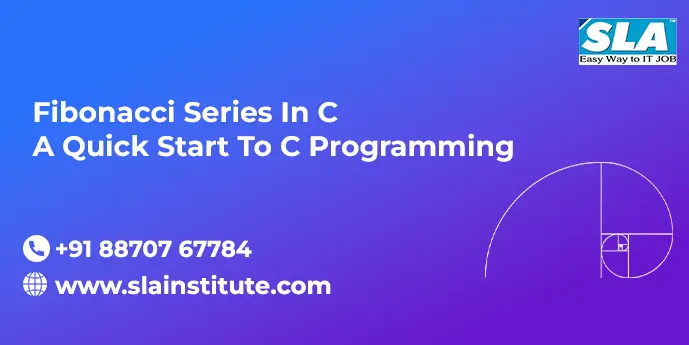Learning about a programming language’s various principles via the lens of the Fibonacci series is a lot of fun. In this tutorial, we’ll have a look at a small sample of C code that will allow you to experiment with the language’s fundamental notions. Hopefully, you have the prerequisites in place to execute C code with any conventional IDE. Understanding the desired result and the methods to get there is necessary before starting to code any notion. Let’s get started with some basic Fibonacci series knowledge in C.
The Fibonacci series
Each subsequent number in the Fibonacci series can be calculated by summing the previous two. Fibonacci’s initial six numbers are 0, 1, 1, 2, 3, 5, and 8. In addition to being the most basic illustration of a recursive issue, the Fibonacci series is also the most famous.
One of the many fascinating features of the Fibonacci sequence is that the ratio of any two successive numbers is roughly equal to the ratio of the following two numbers.
If we divide 5 by 3, we get 1.6666666666667. When we divide 8 by 5, we also get 1.6. It is clear that when one goes further down the list, the ratios approach 1.6.
Programing the Fibonacci Series in C
There is never a change in the first and second terms! The following code snippet demonstrates how to declare such variables in a program.
#include<stdio.h>int main(){int term1 = 0, term2 = 1;int count,nextTerm;//Take the user input to print the seriesprintf(“Enter the number of terms:n”);scanf(“%d”,&count);printf(“The First %d terms of Fibonacci series are :n”,count); for (int j = 0 ; j < count ; j++ ){if ( j <= 1 )nextTerm = j;else{nextTerm = term1 + term2;term1 = term2;term2 = nextTerm;}printf(“%dn”,nextTerm);}return 0;} Output :Enter the number of terms: 8The First 8 terms of the Fibonacci series are :011235813
Recursion in the Fibonacci Series
We’ll need to understand what recursion is and how it works before we can apply it to the Fibonacci series.
Recursive programming, and its advantage
A recursive program is one in which the function repeatedly calls itself. It can be used to solve difficult problems by partitioning them into more manageable chunks. Because of this, recursive programming can be used to solve complex problems.
The Fibonacci series is a well-known use of recursive logic in computer programming. By simply adding the prior two numbers, the Fibonacci series can be created. Those initial digits are 0, 1, 1, 2, 3, 5, 8. The Fibonacci function is invoked to show recursion in action in this application.
#include<stdio.h>int fibonacci(int);int main(){int count, a = 0;printf(“Enter number of terms:”);scanf(“%d”,&count);printf(“nFibonacci series:n”);for (int j= 1 ; j <= count ; j++ ){printf(“%dn”, fibonacci(a));a++;}return 0;}int fibonacci(int num){if ( num == 0 )return 0;else if ( num == 1 )return 1;elsereturn ( fibonacci(num-1) + fibonacci(num-2) );} Output:Enter the number of terms: 6Fibonacci series:011235
Use of the Fibonacci Sequence in Recursive Programming – Learning
Due to its simplicity and intuitive nature, the Fibonacci sequence serves as a great illustration of recursive programming.
The Fibonacci sequence can be used as a teaching tool for three fundamental ideas in recursive programming: the recursive call, the base case, and the stopping condition.
To use a recursive call, a function must first call itself. The initial condition is when the function no longer invokes itself and instead returns a value. When the stopping condition is met, the function will no longer call itself.
Fibonacci Series to a Specific Number
Let’s have a look at the code required to generate a Fibonacci sequence up to a predefined limit.
#include <stdio.h>int main() {int term1 = 0, term2 = 1, nextTerm = 0, n;printf(“Enter a positive number: “);scanf(“%d”, &n);// displays the first two terms which is always 0 and 1printf(“Fibonacci Series is : %d, %d, “, term1, term2);nextTerm = term1 + term2;while (nextTerm <= n) {printf(“%d, “, nextTerm);term1 = term2;term2 = nextTerm;nextTerm = term1 + term2;}return 0;} Output:Enter a positive number: 70Fibonacci Series is : 0, 1, 1, 2, 3, 5, 8, 13, 21, 34, 55
Fibonacci Sequence and Its Uses
In finance, among other fields, the Fibonacci sequence has many useful applications. The realms of botany, music, and architecture are just a few of the many places where the Fibonacci sequence has been put to use. The Fibonacci sequence is commonly employed in botany to determine the total number of flower petals. Rhythms and chord progressions in music can be based on the Fibonacci sequence. Additionally, the Fibonacci series can be employed to achieve aesthetically pleasing symphonic proportions in building design.
Interviews Employing the Fibonacci Sequence
Fibonacci numbers are an excellent way to demonstrate your mastery of recursive algorithms. The ability to build the Fibonacci series in code will undoubtedly impress your interviewer. As well as being a fascinating topic for discussion during job interviews, the Fibonacci sequence is often used as a fun challenge for computer programmers.
The Fibonacci Sequence as a Coding Scheme
Number sequences in code can be generated using the Fibonacci sequence. As an added bonus, the sequence can be used to make fractals, which are infinitely repeating patterns. For making patterns and structures in your code, this can be helpful.
Summary
The Fibonacci series illustrates the concept of recursion in a straightforward way. Learning how to construct the Fibonacci series algorithmically will prepare you for more advanced recursive algorithms. With some experience, you can harness the full potential of recursion to develop code that is both efficient and straightforward. Do you want to learn C or improve your existing knowledge? Enroll in SLA’s C programming course and start enhancing your career prospects today.
